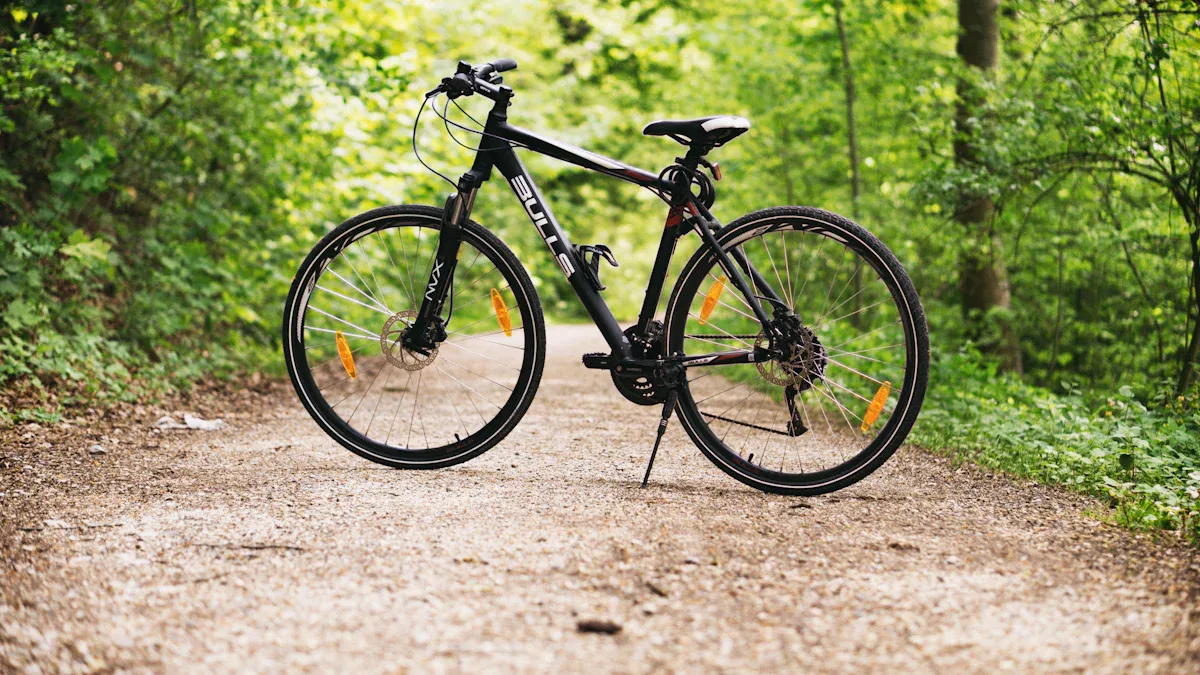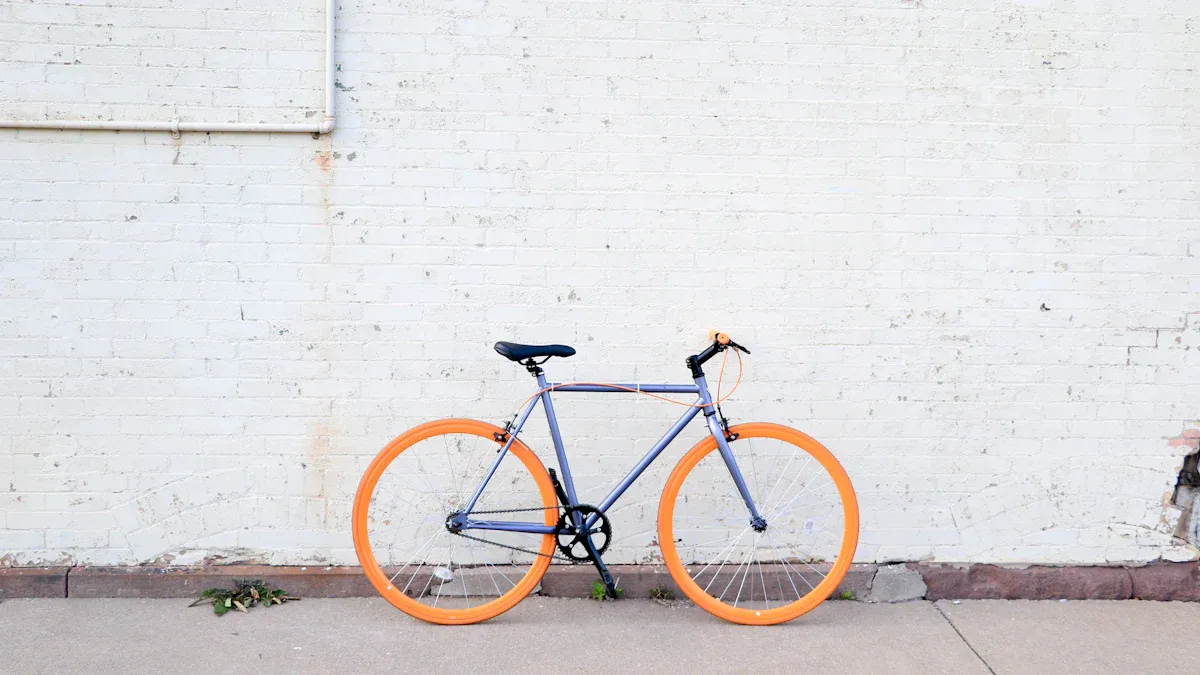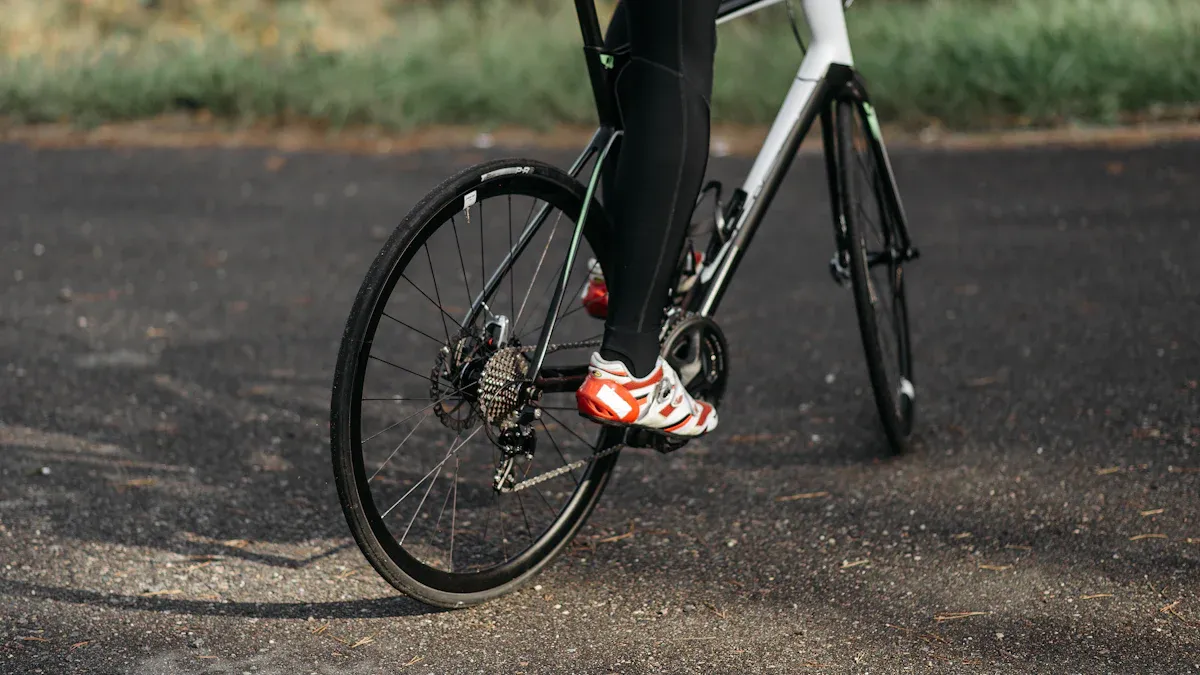
If you are between 5’6″ and 5’10”, a medium frame bike may fit you best. This bike gives you both good balance and easy turning. It helps you move fast on tricky or tight trails. The medium frame lets you handle the bike in a fun way. It also makes climbing hills easier and gives you more control for doing tricks. Look at the table below to see why many people pick this size:
Aspect | Medium Frame Advantages |
|---|---|
Maneuverability | Easier handling on slow, tight, and technical trails |
Climbing | Better position for climbing and quick reactions |
Agility | Less cumbersome on moderate terrain |
If you want a bike that fits well and reacts fast, a medium frame bike could be a good pick.
Key Takeaways
Medium frame bikes fit riders between 5’6″ and 5’10” and offer a good balance of control and comfort.
This bike size works well for many riding styles, including city commuting, trail riding, and road racing.
Check standover height and reach to ensure the bike fits safely and feels comfortable.
Test ride different sizes to find the best fit, as brand sizing and bike shape can vary.
A well-fitted medium frame bike helps you ride confidently and enjoy your time on the bike.
Medium Frame Bike Basics

Mountain Bike Frame Size Guide
When you look for a mountain bike, you need to know your correct frame size. Most medium frames measure between 16 and 18 inches. This number refers to the seat tube length. Some brands use centimeters, while others use inches or labels like S, M, or L. You should always check the frame size guide from the brand you like. The chart below shows how different bike types use different measurements for medium frames:
Bike Category | Rider Height Range | Leg Inseam Range | Medium Frame Size (cm) | Medium Frame Size (inches) |
|---|---|---|---|---|
Road Bikes | 162 – 174 cm | 74 – 78 cm | 53 – 54 cm | 21″ |
Mountain Bikes | 170 – 180 cm | 72 – 77 cm | 42 – 44 cm | 17″ |
Mountain Bikes | 175 – 185 cm | 77 – 81 cm | 45 – 46 cm | 18″ |
City Bikes | 165 – 180 cm | 30.1″ – 31.6″ | N/A | 21″ |
Tip: Always use the brand’s frame size guide before you buy. Each company may have a slightly different way to measure mountain bike frame size.
Mountain bike sizing uses inches or simple labels. Road bikes use centimeters. Wheel size does not help with sizing for adults. You should focus on the frame size and your height or inseam.
Typical Height Range
Medium frames fit most riders between 5’6″ and 5’10”. Some brands recommend medium frames for people from 5’7″ to 5’11”. If you are close to these numbers, you may find a medium frame bike feels right. The table below shows the height ranges for medium frames:
Bike Type | Height Range (cm) | Height Range (ft/in) |
|---|---|---|
Road Bike | 162 – 175 | 5’3″ – 5’8″ |
Mountain Bike | 170 – 180 | 5’7″ – 5’11” |
Mountain bike frame size can change based on your riding style and body shape. If you want more maneuverability, you might pick a medium frame even if you are a little taller or shorter than the usual range. Always check the brand’s sizing chart because mountain bike sizing can be different from one company to another. Try to test ride if you can, since frame geometry and wheel size also affect how the bike feels.
Who Should Ride a Medium Frame Bike
Ideal Rider Profile
A medium frame bike is good if you want both comfort and agility. People who are 5’6″ to 5’10” often fit this size well. If you ride on city streets, trails, or roads, a medium frame works for many places. You might like a medium frame if you want a bike that feels fun but also steady.
How you ride matters when picking a frame. Commuters and fitness riders often use hybrid bikes with medium frames. These bikes have upright seats and medium tires. They feel comfy and work on roads or easy dirt paths. Trail riders pick mountain bikes with medium frames. These bikes are strong, have shocks, and lower gears. You can ride rough trails and climb or go down hills easily. If you race or ride for exercise, road bikes with medium frames are light and shaped for speed. You go faster on roads and get a good fit for quick rides.
Here is a table that shows how your riding style affects your choice of a medium frame bike:
Riding Style | Recommended Bike Type | Key Features Affecting Medium Frame Choice |
|---|---|---|
Commuting/Fitness | Hybrid Bikes | Upright position, medium-width tires, comfort and versatility on paved and light off-road surfaces |
Trail Riding | Mountain Bikes (Trail, All-Mountain) | Sturdy frames, shock absorption, lower gears for rough terrain, balanced geometry for uphill and downhill |
Racing/Performance | Road Bikes (Endurance, Performance) | Lightweight, aerodynamic, drop-bar handlebars, designed for speed on paved roads |
Tip: Always match your bike’s shape and size to how and where you ride. This helps you get the best fit and ride better.
If you are between sizes, you might not know which to pick. What you like and how you ride matter a lot. Some people close to the edge of medium size pick medium for easier turning. Others pick large for more steadiness. Try both if you can and see how standing over the bike feels. The right fit keeps you safe and makes riding more fun.
Stability vs. Maneuverability
When you look at frame sizes, you see big changes in how bikes ride. Large frames feel steady at high speeds and on steep hills. You feel safe going fast or down big hills, but the bike can feel heavy in tight spots. Small frames turn quickly and handle tricky trails well, but you lose some steadiness on fast or bumpy rides.
Medium frames give you both steadiness and quick moves. You get enough balance for most trails and can still play around. Many pro riders who are about 5’11” pick medium frames for better turning, even if they could use a large. Tests show medium frames do better in slow, twisty parts, while large frames are a bit faster on straight downhills. The fun and options of a medium frame are often better than the small speed gain of a large.
Large frames are best for going fast and down steep hills.
Small frames are great for quick turns and tricky trails.
Medium frames mix steadiness and quick moves, so they work for many trails.
Standover height matters. Make sure you can stand over the bike easily. This helps you control the bike and stay safe.
Bike shape, like reach, changes how the bike fits and rides. Medium frames usually have reach numbers that fit lots of people and styles.
One rider tried both medium and large frames. The large felt steady on fast hills but was hard to turn in tight spots. The medium was steady enough for most trails and felt more fun. You might find a medium frame bike is best if you want a bike that works well in many places.
Note: Always check standover height and reach when you try a bike. These numbers help you find the best fit for your body and how you ride.
How to Check Your Fit

Key Fit Points
You want your bike fit to feel right from the start. Begin by checking the frame size. If you pick the wrong size, you will not get the comfort you need. Stand over the bike with your feet flat and your cycling shoes on. You should see at least 2 inches of standover clearance. This standover space helps you mount and dismount safely. Reach is another key point. Reach measures the distance from the bottom bracket to the head tube. If the reach is too long, you will feel stretched. If it is too short, you will feel cramped. Good reach helps you control the bike and pedal well.
Look at the top tube length. This sets your upper body position. Adjust the seat height so your leg bends slightly at the bottom of each pedal stroke. Move the seat forward or back so your knee lines up over the ball of your foot when the pedal is at 3 o’clock. Keep the saddle tilt flat for comfort. You can swap stems to change handlebar reach and height. These steps help you get the best fit for your medium frame bike.
Fit Point | Description | Importance for Medium Frame Bike Fit |
|---|---|---|
Reach | Distance from bottom bracket to head tube center. | Controls forward lean and handlebar reach. |
Standover Height | Clearance between top tube and groin. | At least 2″ standover keeps you safe and comfortable. |
Wheelbase | Distance between front and rear axles. | Affects stability and maneuverability. |
Chainstay Length | Distance from bottom bracket to rear axle. | Impacts rear stability and nimbleness. |
Stack | Vertical distance from bottom bracket to head tube center. | Sets handlebar height and comfort. |
Tip: Always use sizing advice from the brand and check standover before you buy. Sizing advice helps you avoid mistakes.
Test Ride Tips
Test riding gives you the best advice for finding your fit. Start by straddling the bike. Make sure you have enough standover clearance. Adjust the saddle height so your leg bends 80-90% at the bottom of the pedal stroke. Slide the saddle forward or back to line up your knee over the pedal axle. Keep the saddle tilt flat. Check your reach to the handlebars. Your arms should bend slightly. Handlebar width should match your shoulders for control. If you feel pain or discomfort, ask for more sizing advice at the bike shop.
Manufacturer sizing charts help you start, but they do not always give a perfect fit. Geometry and sizing change between brands. You should use sizing charts, but always test ride and check standover and reach. Professional bike fit sessions can help, but you need a final fitting on your actual bike. This step makes sure your bike fit matches your body and riding style.
Note: Never rely only on sizing charts. Always check standover, reach, and comfort with a test ride for the best bike fit.
You get the most from a medium frame bike if you want both balance and quick moves on many trails. Always look at sizing charts, measure your inseam, and try riding the bike before you choose. Some riders make mistakes when they forget about frame shape or do not check if the bike fits. Listen to experts and use frame calculators to help you pick better. After you buy your bike, ask your local shop for help to make it comfy and work well.
Remember: The right fit helps you feel sure of yourself and makes every ride more fun.
FAQ
What height fits a medium frame bike best?
You fit a medium frame bike if you stand between 5’6″ and 5’10”. Always check the brand’s sizing chart before you buy. Your inseam also helps you pick the right size.
Can you use a medium frame for trail and city riding?
You can use a medium frame bike for both trail and city riding. This size gives you good control and comfort on different surfaces. Many riders like the balance it offers.
How do you know if a medium frame is too small or large?
You know the frame is too small if you feel cramped or your knees hit the handlebars. The frame is too large if you stretch too much or cannot stand over the bike easily.
Is a medium frame good for the best beginner mountain bike?
You find that many best beginner mountain bike models use medium frames. This size helps you learn skills and gives you confidence on trails. You get a mix of stability and easy handling.
See Also
Unexpected Advantages Shared By Small Frame Mountain Bike Riders
Key Factors To Determine The Perfect Bike Frame Fit
Determining The Ideal Height For Large Bike Frame Sizes
